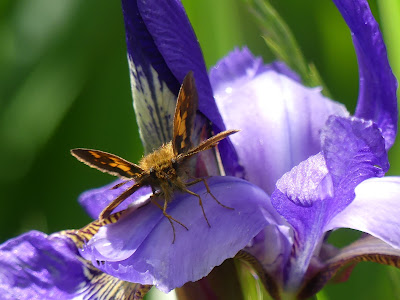As well as the water level receeding, the reeds have began leaning in to the rides in the month that we've been away, and a shoots have also started to emerge from the ride floors so we set aside a few hours to tidy up. There had been an emergence of small flies and we could see Reed Warblers moving onto the cut stems where they were easier to feed on. We had a bit of spare time so erected a 40ft net and caught 6 birds within the hour.
There have been more site changes with large volumes of soil removed from the soil heaps directly next to what has become the flattened grassy area. There will be no trying for Meadow Pipits there anymore, but at least we will be able to attempt to catch them on the new meadow.
15th Totals: 6
Robin - 1
Reed Warbler - 5
We returned on the 19th hoping to get some more Reed Warblers from previous years, and to capture non-reedbed species moving through the heavily overgrown banks of the soil heap mounds. We have noticed that large volumes of soil continue to be removed from the mounds and the end of our 60ft&40ft run has been truncated and now ends in a sheer drop some 10 feet deep. We will have to see how the work progresses at the site.
19th Totals: 10 (5)
Reed Warbler - 4 (5)
Lesser Whitethroat - 1
Whitethroat - 1
Greenfinch - 2
Goldfinch - 1
Linnet - 1
We had been led to expect the work would be finished by the 22nd but there was still more finishing off to be done. We know that the banks are to be lessened in height to soften the drops where soil has been removed and hope that this won't alter the way in which birds use the site too much. This morning there was no HGV activity in that direct area so we put up a single net close to a puddle where House Martins have been collecting mud. There were no hirundines captured but it did work rather well for Linnets coming in to drink. The reedbed was fairly quiet, almost as though the resident Reed Warbler adults are now aware that nets may be there from time to time. We'll just have to wait for when the youngsters start moving about. As a bonus the small back flies are still there in their thousands and an excellent food source for the Reed Warblers.
22nd Totals: 15 (5)
We returned on the 19th hoping to get some more Reed Warblers from previous years, and to capture non-reedbed species moving through the heavily overgrown banks of the soil heap mounds. We have noticed that large volumes of soil continue to be removed from the mounds and the end of our 60ft&40ft run has been truncated and now ends in a sheer drop some 10 feet deep. We will have to see how the work progresses at the site.
3JJ Lesser Whitethroat
19th Totals: 10 (5)
Reed Warbler - 4 (5)
Lesser Whitethroat - 1
Whitethroat - 1
Greenfinch - 2
Goldfinch - 1
Linnet - 1
We had been led to expect the work would be finished by the 22nd but there was still more finishing off to be done. We know that the banks are to be lessened in height to soften the drops where soil has been removed and hope that this won't alter the way in which birds use the site too much. This morning there was no HGV activity in that direct area so we put up a single net close to a puddle where House Martins have been collecting mud. There were no hirundines captured but it did work rather well for Linnets coming in to drink. The reedbed was fairly quiet, almost as though the resident Reed Warbler adults are now aware that nets may be there from time to time. We'll just have to wait for when the youngsters start moving about. As a bonus the small back flies are still there in their thousands and an excellent food source for the Reed Warblers.
5F Reed Bunting
22nd Totals: 15 (5)
Dunnock - 1 (1)
Robin - 2
Blackbird - 1
Reed Warbler - 1 (3)
Lesser Whitethroat - 0 (1)
Blackcap - 1
Chiffchaff - 2
Linnet - 6
Reed Bunting - 1
Reed Bunting - 1


































































